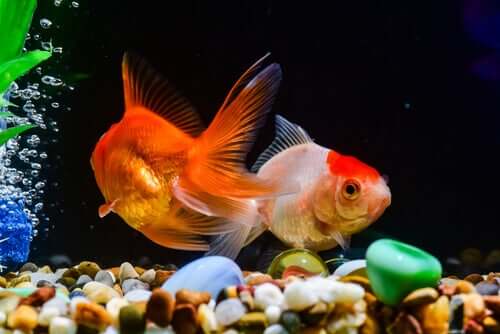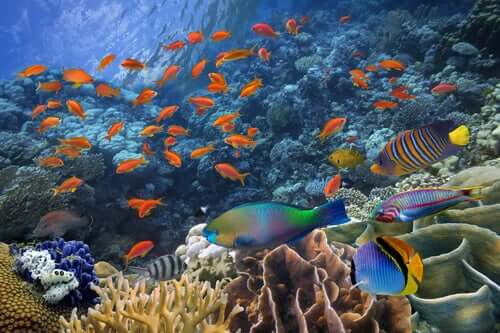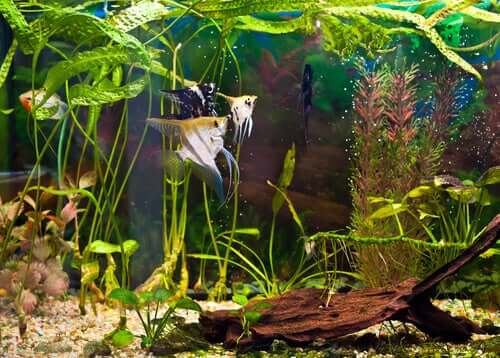Discover the Best Fish Food Tips

There are many fish species in the world. Each requires a specific diet, in which the temperature and climate also play a role. When it comes to fish food, it’s essential that what you feed your fish meets the nutritional needs of each species.
Fish food: nutritional characteristics of different species
Fish can be carnivores, herbivores, or omnivores, depending on the species. Knowing the habits and nutritional needs of your fish is the first step to providing them with a balanced diet.
Carnivorous fish
Carnivorous fish are usually predators in their natural habitat. They have a short bowel and eat once or twice a day. Their bodies easily digest proteins, which provide prolonged satiety.
Also, they can feed on crustaceans, mollusks, and smaller sized fish, such as sardines and herring. The main specimens of carnivorous fish are tuna and sharks.

Although they have sharp teeth, carnivorous fish don’t chew food. In fact, their teeth serve to hunt and catch prey. The food these fish consume is actually crushed in their esophagus and stomach.
Herbivorous fish
There are very few species of strictly herbivorous fish. These animals basically feed on plants native to the aquatic flora. They can be found in saltwater or freshwater.
In addition, these fish have long intestines because plants require a prolonged digestive process. Also, they usually feed several times a day to satisfy their nutritional needs. The best-known herbivorous species are the Mediterranean Rainbow Wrasse and Dreamfish.
Omnivorous fish
Many aquarium fish are omnivores. This is an important skill for adaptation and survival. These animals are opportunistic and feed both on animal and vegetable proteins. Their habits depend basically on the habitat they’re exposed to.
Usually, they feed two to three times a day, according to the proportion of protein they consume.
Fish food tips for aquarium fish
You have to be careful to avoid mistakes when choosing the proper fish food for aquarium fish.
Thus, it’s essential to know what species of fish you have so you can provide them a proper diet. Then, you can follow the following tips:
1. Don’t overfeed your fish
Choosing a good commercial feed according to the species of your fish is essential. But knowing when and how to feed them is equally important.
Overfeeding and excess weight are risk factors for the health of your fish. In fact, many usually die due to the disease known as “fatty liver”.
Most owners overfeed their fish. And that isn’t only dangerous for the weight of your fish. In fact, the accumulation of food at the bottom is the most common source of contamination in aquariums.
Experts recommend the following ratio: 0.4 g a day per every 10 g of fish in the aquarium.
2. Make sure all your fish eat
The way you need to feed your fish also varies depending on the species. Each fish is anatomically prepared to eat at a certain place. Some eat on the surface, others in the middle, and some at the bottom of the tank.
Therefore, it’s very important to pay special attention when you feed your fish. We recommend observing their habits to ensure that all of them are fed.
3. Providing live food
Dry commercial feed is an excellent staple food for fish. Among other things, it contains the right proportions for each species.

However, live food is essential for the nutrition and digestive and reproductive process of fish. It provides 100% natural protein and fiber.
Ideally, make a mixture with bloodworms, shrimp, and sludge worms. This mixture is ideal for carnivorous and omnivorous fish.
On the other hand, you can feed algae and aquatic plants to herbivorous fish. Also, you can blanch lettuce and spinach in boiling water and feed them to your fish.
4. Avoid accumulation of food
In addition to respecting the daily amounts of food, you should clean the inside of the fish tank once a month. Remember to also have an adequate filter system to keep the water in good condition.
5. Fish food in winter
If your fish tank has adequate heating, your fish shouldn’t show any dietary changes during the winter. Thus, you can feed your fish two to four times a day, as usual.
But, when you choose to let the fish go into hibernation, you should only feed them once a day. Normally, fish trigger the hibernation process when the temperature is lower than 50°F.
